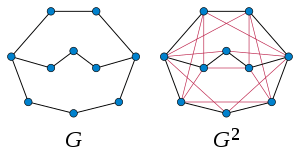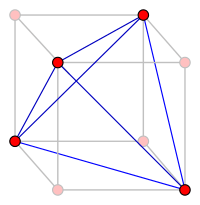Graph power
In graph theory, a branch of mathematics, the kth power Gk of an undirected graph G is another graph that has the same set of vertices, but in which two vertices are adjacent when their distance in G is at most k. Powers of graphs are referred to using terminology similar to that of exponentiation of numbers: G2 is called the square of G, G3 is called the cube of G, etc.[1]

Graph powers should be distinguished from the products of a graph with itself, which (unlike powers) generally have many more vertices than the original graph.
Properties
If a graph has diameter d, then its d-th power is the complete graph.[2] If a graph family has bounded clique-width, then so do its d-th powers for any fixed d.[3]
Coloring
Graph coloring on the square of a graph may be used to assign frequencies to the participants of wireless communication networks so that no two participants interfere with each other at any of their common neighbors,[4] and to find graph drawings with high angular resolution.[5]
Both the chromatic number and the degeneracy of the kth power of a planar graph of maximum degree Δ are , where the degeneracy bound shows that a greedy coloring algorithm may be used to color the graph with this many colors.[4] For the special case of a square of a planar graph, Wegner conjectured in 1977 that the chromatic number of the square of a planar graph is at most , and it is known that the chromatic number is at most .[6][7] More generally, for any graph with degeneracy d and maximum degree Δ, the degeneracy of the square of the graph is O(dΔ), so many types of sparse graph other than the planar graphs also have squares whose chromatic number is proportional to Δ.
Although the chromatic number of the square of a nonplanar graph with maximum degree Δ may be proportional to Δ2 in the worst case, it is smaller for graphs of high girth, being bounded by O(Δ2/log Δ) in this case.[8]
Determining the minimum number of colors needed to color the square of a graph is NP-hard, even in the planar case.[9]
Hamiltonicity
The cube of every connected graph necessarily contains a Hamiltonian cycle.[10] It is not necessarily the case that the square of a connected graph is Hamiltonian, and it is NP-complete to determine whether the square is Hamiltonian.[11] Nevertheless, by Fleischner's theorem, the square of a 2-vertex-connected graph is always Hamiltonian.[12]
Computational complexity
The kth power of a graph with n vertices and m edges may be computed in time O(mn) by performing a breadth first search starting from each vertex to determine the distances to all other vertices, or slightly faster using more sophisticated algorithms.[13] Alternatively, If A is an adjacency matrix for the graph, modified to have nonzero entries on its main diagonal, then the nonzero entries of Ak give the adjacency matrix of the kth power of the graph,[14] from which it follows that constructing kth powers may be performed in an amount of time that is within a logarithmic factor of the time for matrix multiplication.
The kth powers of trees can be recognized in time linear in the size of the input graph. [15]
Given a graph, deciding whether it is the square of another graph is NP-complete. [16] Moreover, it is NP-complete to determine whether a graph is a kth power of another graph, for a given number k ≥ 2, or whether it is a kth power of a bipartite graph, for k > 2.[17]
Induced subgraphs

The half-square of a bipartite graph G is the subgraph of G2 induced by one side of the bipartition of G. Map graphs are the half-squares of planar graphs,[18] and halved cube graphs are the half-squares of hypercube graphs.[19]
Leaf powers are the subgraphs of powers of trees induced by the leaves of the tree. A k-leaf power is a leaf power whose exponent is k.[20]
References
- Bondy, Adrian; Murty, U. S. R. (2008), Graph Theory, Graduate Texts in Mathematics, 244, Springer, p. 82, ISBN 9781846289699.
- Weisstein, Eric W. "Graph Power". MathWorld.
- Todinca, Ioan (2003), "Coloring powers of graphs of bounded clique-width", Graph-theoretic concepts in computer science, Lecture Notes in Comput. Sci., 2880, Springer, Berlin, pp. 370–382, doi:10.1007/978-3-540-39890-5_32, MR 2080095.
- Agnarsson, Geir; Halldórsson, Magnús M. (2000), "Coloring powers of planar graphs", Proceedings of the Eleventh Annual ACM-SIAM Symposium on Discrete Algorithms (SODA '00), San Francisco, California, USA, pp. 654–662.
- Formann, M.; Hagerup, T.; Haralambides, J.; Kaufmann, M.; Leighton, F. T.; Symvonis, A.; Welzl, E.; Woeginger, G. (1993), "Drawing graphs in the plane with high resolution", SIAM Journal on Computing, 22 (5): 1035–1052, doi:10.1137/0222063, MR 1237161.
- Kramer, Florica; Kramer, Horst (2008), "A survey on the distance-colouring of graphs", Discrete Mathematics, 308 (2–3): 422–426, doi:10.1016/j.disc.2006.11.059, MR 2378044.
- Molloy, Michael; Salavatipour, Mohammad R. (2005), "A bound on the chromatic number of the square of a planar graph", Journal of Combinatorial Theory, Series B, 94 (2): 189–213, doi:10.1016/j.jctb.2004.12.005, hdl:1807/9473, MR 2145512.
- Alon, Noga; Mohar, Bojan (2002), "The chromatic number of graph powers", Combinatorics, Probability and Computing, 11 (1): 1–10, doi:10.1017/S0963548301004965, MR 1888178.
- Agnarsson & Halldórsson (2000) list publications proving NP-hardness for general graphs by McCormick (1983) and Lin and Skiena (1995), and for planar graphs by Ramanathan and Lloyd (1992, 1993).
- Bondy & Murty (2008), p. 105.
- Underground, Polly (1978), "On graphs with Hamiltonian squares", Discrete Mathematics, 21 (3): 323, doi:10.1016/0012-365X(78)90164-4, MR 0522906.
- Diestel, Reinhard (2012), "10. Hamiltonian cycles", Graph Theory (PDF) (corrected 4th electronic ed.).
- Chan, Timothy M. (2012), "All-pairs shortest paths for unweighted undirected graphs in time", ACM Transactions on Algorithms, 8 (4): A34:1–A34:17, doi:10.1145/2344422.2344424, MR 2981912
- Hammack, Richard; Imrich, Wilfried; Klavžar, Sandi (2011), Handbook of Product Graphs, Discrete Mathematics and Its Applications (2nd ed.), CRC Press, p. 94, ISBN 9781439813058.
- Chang, Maw-Shang; Ko, Ming-Tat; Lu, Hsueh-I (2015), "Linear-Time Algorithms for Tree Root Problems", Algorithmica, 71 (2): 471–495, doi:10.1007/s00453-013-9815-y.
- Motwani, R.; Sudan, M. (1994), "Computing roots of graphs is hard", Discrete Applied Mathematics, 54: 81–88, doi:10.1016/0166-218x(94)00023-9.
- Le, Van Bang; Nguyen, Ngoc Tuy (2010), "Hardness results and efficient algorithms for graph powers", Graph-Theoretic Concepts in Computer Science: 35th International Workshop, WG 2009, Montpellier, France, June 24-26, 2009, Revised Papers, Lecture Notes in Computer Science, 5911, Berlin: Springer, pp. 238–249, doi:10.1007/978-3-642-11409-0_21, ISBN 978-3-642-11408-3, MR 2587715.
- Chen, Zhi-Zhong; Grigni, Michelangelo; Papadimitriou, Christos H. (2002), "Map graphs", Journal of the ACM, 49 (2): 127–138, arXiv:cs/9910013, doi:10.1145/506147.506148, MR 2147819.
- Shpectorov, S. V. (1993), "On scale embeddings of graphs into hypercubes", European Journal of Combinatorics, 14 (2): 117–130, doi:10.1006/eujc.1993.1016, MR 1206617.
- Nishimura, N.; Ragde, P.; Thilikos, D.M. (2002), "On graph powers for leaf-labeled trees", Journal of Algorithms, 42: 69–108, doi:10.1006/jagm.2001.1195.